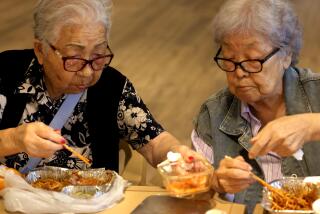Not in my lobby
- Share via
The urban pioneers who’ve bought pricey downtown living spaces are understandably eager to see their rough-and-tumble surroundings gentrify quickly. Their investment in the neighborhood, however, doesn’t guarantee that it will change. Poverty, homelessness and the services that address them have become institutionalized downtown, largely because the rest of the county wants it that way. The more buildings converted to live-work spaces, the more friction between new residents and the needier souls who preceded them.
Sparks are flying these days at Little Tokyo Lofts on San Pedro near 4th Street, a converted industrial building a block from the Los Angeles Mission. Owners of the condos, which sell for $400,000 to $1.2 million, were stunned to learn a few weeks ago that a treatment center was moving into the ground floor of their building. Clients at SSG Central are offenders (nonviolent for the most part) with mental health and substance abuse problems whom the courts have diverted into supervised treatment instead of putting behind bars. In other words, they’re a lot like many of downtown’s longtime denizens, except they’re on a court-supervised path toward a productive life.
Not surprisingly, residents of the building would prefer that its retail space be filled with restaurants and other businesses that would serve them. They worry that SSG’s clients will threaten their safety despite the extra security provided, and that the stigma will drive down the value of their property. They may not have much say in the matter. Steve Lee, who owns all the retail space at Little Tokyo Lofts, insists that SSG’s presence is legal and above reproach. Nevertheless, developers of the building are examining whether Lee violated any of the terms of his deal when he brought in SSG.
One irony here is that SSG would rather not be in that building either. Its clients, who are housed near the USC campus, have to travel through skid row to reach their therapists and counselors at Little Tokyo Lofts -- not an ideal scenario for recovering addicts. But SSG officials say they couldn’t find the space they needed at a price they could afford anywhere but downtown.
If the new residents and investors downtown start fighting with service providers for the homeless and the afflicted, no one wins. There aren’t enough services for the county’s homeless population -- estimated at more than 82,000 at the end of 2005 -- and too few communities are willing to accept the permanent housing and mental health and substance abuse centers that should be dispersed across Los Angeles. City and county officials should give service providers more help in finding spaces that work best for everyone, but those who migrate downtown need to accept that new condos and coffee shops aren’t the only tools for cleaning up the neighborhood.
More to Read
Sign up for Essential California
The most important California stories and recommendations in your inbox every morning.
You may occasionally receive promotional content from the Los Angeles Times.










